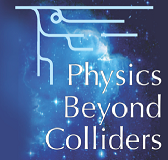The experimental evidence for BSM physics such as the non-zero neutrino masses, the baryon asymmetry in the Universe, and the presence of non-baryonic dark matter may have their origin in new physics involving very weakly interacting particles as predicted by models with a secluded or hidden sector of particles. In general, these models contain mediators that couple very weakly with SM...
The NA64 is a fixed-target experiment aiming to search for dark sector physics with a high-energy electron beam at the CERN SPS. The experiment uses a new approach combining the active beam dump and missing energy techniques. We present the future NA64 research program which is significantly extended
%and has a certain advantages compared to the classical beam dump approach.
by...
A measurement of the proton EDM to better than 10-29ecm, or better, allows us to probe physics in a new regime up to ~3PeV mass scale. The use of the storage ring EDM technique permits 5 orders of magnitude improvement over current indirect measurements of dp (from Hg) and 3 orders magnitude more sensitivity on QCD inferred from neutron EDM measurements. Non-zero values of the pEDM would...
Precise measurements of the branching ratios (BRs) for the flavor-changing
neutral current decays $K\to\pi\nu\bar{\nu}$ can provide unique constraints
on CKM unitarity and, potentially, evidence for new physics. It is important
to measure both decay modes, $K^+\to\pi^+\nu\bar{\nu}$ and
$K_L\to\pi^0\nu\bar{\nu}$, since different new physics models affect the rates
for each channel differently....
The anomalous magnetic moment g-2 of the muon is a precision measurement which exhibits a 3.5$\sigma$ deviation between theory and experiment, and in the next few years will be measured at Fermilab and J-PARC with even higher precision.
The hadronic contribution to the muon g-2 ($a^{\rm HLO}_{\mu}$) is the most important one after the pure QED contribution. It is however affected by a large...
The lifetime of the short-lived ($\tau_{th}$ about $3\times10^{-15}$ s in the ground state) $\pi^+K^-$, $K^+\pi^-$, ($\pi^+\pi^-$ ) atoms($A_{\pi^+K^-}$, $A_{K^+\pi^-}$ and $A_{2\pi}$ ) is given within 1% (0.6%) precision by the S-wave $\pi K$ ($\pi\pi$) scattering length combination $|a_{1/2}-a_{3/2}|$ ($|a_0-a_2|$), where 1/2, 3/2 (0, 2) are the isospin values. Furthermore, the study of...
The theory of strong interactions, Quantum Chromodynamics (QCD), predicts a rich variety of different phases of strongly interacting matter. The QCD phase diagram is usually represented as a function of the temperature and baryon density. At sufficiently high temperatures, a transition from hadronic matter to a Quark-Gluon Plasma (QGP), a state where quarks and gluons are no more confined...
This contribution discusses the possibility of broadening the present CERN research programme by a new component, making use of a novel concept of the light source. The proposed, partially stripped ion beam driven, light source is the backbone of the Gamma Factory initiative. It could be realized at CERN by using the infrastructure of the already existing accelerators. It could push the...
In this talk, we review a number of recent ideas$^*$ put forward in favour of a fixed-target programme at the LHC - AFTER@LHC- dedicated to heavy-ion, hadron, spin and astroparticle physics. By extracting the beam with a bent crystal or by using an internal gas target, the multi-TeV LHC beams allow one to perform the most energetic fixed-target experiments ever with which one can access the...
The magnetic moments of baryons containing u,d and s quarks have been extensively studied and measured. The experimental results are all obtained by a well-assessed method that consists in measuring the polarisation vector of the incoming particles and the precession angle when the particle is travelling through an intense magnetic field. The polarization is evaluated by analysing the angular...
The AWAKE experiment [1] will be taking data over the next two years
to establish the method of proton-driven plasma wakefield
acceleration. An R&D programme is being formulated for post-LS2 in
which the AWAKE experiment demonstrates [2] that bunches of about $10^9$
electrons with an energy of 10 GeV accelerated in about 10 m of
plasma are achievable and that the energy gain is scalable...
Axions are a natural consequence of the Peccei-Quinn mechanism, the most compelling solution to the strong-CP problem. Similar axion-like particles (ALPs) also appear in a number of possible extensions of the Standard Model, notably in string theories. Both axions and ALPs woudl be copiously produced at the sun's interior, and in addition they are very well motivated candidates for the Dark...
Sensitive measurements on the short range interactions between macroscopic bodies provide a window on possible physics beyond the standard model, including extra-dimensions, scalar dark matter and dilatons. The sub-micron scale distances is presently not accessible to experimental investigation, and may hold the key to understanding at least part of the dark matter puzzle.
The a-KWISP...
The DarkSide-50 dark matter detector at LNGS is a two-phase argon TPC, installed at the center of two nested veto detectors, a 30-tonne liquid scintillator neutron veto and a 1,000-tonne water Cherenkov muon veto. While operating in 2014 with a fill of argon extracted from the atmosphere, DarkSide-50 demonstrated its capability to operate in a background-free mode even in presence of the...
